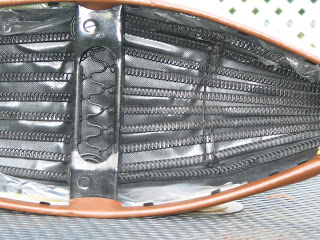 The seat was a complete rust bucket, but complete nonetheless. In the fall of 2005 I began restoration on the seat. I researched online for the best way to remove the rust and preserve the integrity of the springs. Acid dipping would be a clear mistake. I consulted my mentor, Christopher Markley of Moto-Rapido, and we discussed the options. He suggested the “way of least resistance.”
The seat was a complete rust bucket, but complete nonetheless. In the fall of 2005 I began restoration on the seat. I researched online for the best way to remove the rust and preserve the integrity of the springs. Acid dipping would be a clear mistake. I consulted my mentor, Christopher Markley of Moto-Rapido, and we discussed the options. He suggested the “way of least resistance.”Note: Though Christopher is young – he is of the old world. Body work and mechanical work are done the way our forefathers would have done it. This type of craftsmanship is very difficult to find these days. My wife and I have learned that Christopher is a anal retentive meticulous obsessive perfectionist that will not say a job is done until it is to the spec per the original manufacturer or his client’s request.
Christopher and I agreed upon electrolysis. In a dummy-downed definition, it is filling a bucket with water and connecting a car battery to a coat hanger and electrocuting the water and the rusted item inside the bucket. This is the gentlest approach and proved to be easiest on the seat springs.
Before I did anything, I brought the seat “as-is” to reupholster shop, named Dura-Fit Cover, Inc. located in Harrisburg, PA. I was quoted $150 for reupholstering the seat if I brought the seat frame in 100% restored. The price for a brand new seat was about $130. We opted to restore the seat.
Feeding his karma chain (which he does often), Christopher volunteered to de-rust the seat frame/springs with electrolysis after I sought his direction on “how-to” do it. Furthermore, he said because I was a poor college student again becoming a teacher, he would powder coat the seat frame/springs in black for free for us. He had recently purchased the tools to powder coat. He returned to us a slightly pitted, but perfectly sound and functional seat frame and springs that will weather well over time.
 Next I brought the seat to Dura-Fit Cover, Inc. I was informed that the foam was in great shape and could be reused with a new thin layer on top to give perfect shape to it. Lisa and I wanted a British Racing Green paint job and a complimenting brown seat. I brought home a small handful of marine vinyl samples that were for boats and outdoor usage. Dura-Fit took a few months to complete the seat, but it looked great. I was able to reuse the strap-on hardware and the seat lock release. In an effort to preserve the SS’s soul I made sure to have the seat’s “Milano” branded tag in the back of the seat; although I did not preserve the stitching, vinyl color, and the black crusted and cracked seat strap. I will keep my eyes open for a matching seat strap and add it to the seat once I find it.
Next I brought the seat to Dura-Fit Cover, Inc. I was informed that the foam was in great shape and could be reused with a new thin layer on top to give perfect shape to it. Lisa and I wanted a British Racing Green paint job and a complimenting brown seat. I brought home a small handful of marine vinyl samples that were for boats and outdoor usage. Dura-Fit took a few months to complete the seat, but it looked great. I was able to reuse the strap-on hardware and the seat lock release. In an effort to preserve the SS’s soul I made sure to have the seat’s “Milano” branded tag in the back of the seat; although I did not preserve the stitching, vinyl color, and the black crusted and cracked seat strap. I will keep my eyes open for a matching seat strap and add it to the seat once I find it. I recognize that this seat & bike is not restored to its original state, but this bike is being restored and customized for my wife, Lisa.
I recognize that this seat & bike is not restored to its original state, but this bike is being restored and customized for my wife, Lisa.Note: Due to a hard drive crash two years ago I lost the photos of the seat & frame in its original state and after Christopher Markley prepped it. You can find pictures of the seat in the "History" post below. Click on photo to zoom in on it.


